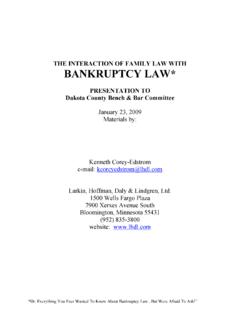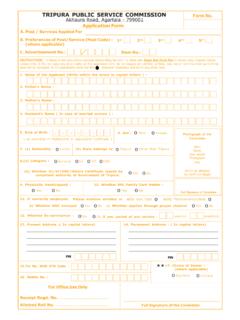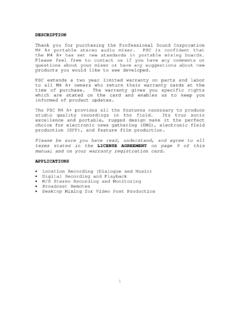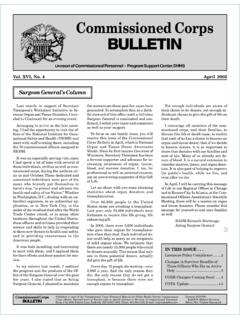Transcription of Personal Service Corporations: AWaltz Through the Minefield
1 Personal Service Corporations: A Waltz Through the Minefield Todd I. Freeman All section references are to the Internal Revenue Code ( IRC ) unless otherwise indicated. AICPA refers to the American Institute of Certified Public Accoun- tants; IRS, to the Internal Revenue Service ; PSC, to Personal Service corpora- tion; Secretary, to the Secretary of the Treasury; and Treasury, to the Department of the Treasury. A. Introduction 1. The Treasury's exposure to Service corporations had its beginnings in the late 1960s and early 1970s when the IRS refused to recognize as taxable enti- ties those corporations being formed under professional corporation statutes of the various states. The attacks were waged Through audits and litigation premised on the view that professional corporations were illegitimate cre- ations of lobbying groups in various states that had no semblance to a busi- ness.
2 The individual Service provider was the creator of the income, not the corporation, claimed the IRS, and continued its attack on an assignment-of- income theory. Finally, in the early 1970s the IRS acquiesced to the cases it lost and formally recognized professional corporations. Todd I. Freeman, , is a shareholder in Larkin, Hoffman, Daly & Lindgren, Ltd., Minneapolis. He is a fellow of the American College of Trust and Estate Counsel and is a member of the American Institute of Certified Public Accountants. A complete set of the course materials from which this outline was drawn may be purchased from ALI-ABA. Call 1-800-CLE-NEWS, and ask for Customer Service . Have the product number of the course materials SF69 handy. 5. 6 ALI-ABA Business Law Course Materials Journal October 2001.
3 2. As the professions developed and the services provided broadened into areas not requiring licensure, the selective rules desired by the Treasury broadened to nonprofessional Service corporations as well. 3. Legislation proliferated against Service corporations to the extent that they now need special attention. The IRC is riddled with provisions affecting var- ious types of Service corporations. 4. It is difficult to identify when and which corporation is being identified under each relevant provision of the IRC. Although some situations are clear, there are many that may fit one or several of the nine definitions or concepts of ser- vice corporations discussed below but not fit others. B. Identification of a Service Corporation. 1.
4 There are nine different types and definitions of Service corporations that are the subject of restrictions or penalties under the IRC. In addition, state law has its own classifications of Service corporations that must be considered in some instances for state income tax purposes. The first step in analyzing the situa- tion for a client corporation is to determine if the client is subject to any of these restrictions by meeting the definitions. If the definition is met then the substantive restriction would be reviewed and planning would either attempt to minimize the effect of the restriction, or change the entity to fall outside of, or arguably outside of, the definition 2. IRC. Because the tax definition of a corporation includes associations (see 7701(a)(3)), limited liability companies, or any other entity electing to be taxed as a corporation under the check-the-box rules will likewise be sub- ject to all of the rules discussed below.
5 A. PSC I ( 269A(b)). Section 269A empowers the Secretary to reallocate in- come and tax attributes between PSCs and employee-owners if the condi- tions stated in the statute are satisfied. This definition is also used to disal- low deductions for golden parachute payments made to PSCs that are treated as individuals. 280G(c) and Treas. Reg. , Q&A-16. A PSC. means a corporation the principal activity of which is the performance of Personal services and such services are substantially performed by employee-owners. Employee-owner is an employee that owns, at any time during the taxable year, more than 10 percent of the stock of the cor- poration. Attribution under section 318 applies except that the attribution from a corporation can occur with five percent ownership rather than the Personal Service Corporations 7.
6 50 percent ownership identified in section 318(a)(2)(C). The proposed Treasury Regulations do not give any guidance on interpreting the words principal activity, substantially performed, and Personal services .. b. PSC II ( 469(j)(2)). The definition of the second type of PSC is a modifica- tion of the first definition described above from section 269A. Falling within this definition would subject the corporation to limits on the deductibility of passive losses under section 469(a) and tax shelter farm activity losses under section 58(a)(3). This definition is broader than the above definition because employee-owner applies to an employee that owns any stock in the corporation. In addition, the attribution of owner- ship of a corporation under section 318 will apply regardless of the level of ownership of the attributing corporation.
7 I. To temper the breadth of the application of this definition for any type of ownership by an employee whatsoever, the definition of PSC II will not apply unless more than 10 percent of the stock by value in the corporation is held by employee-owners. This would exclude, for example, corpora- tions that provide Personal services that are publicly-held where employ- ees collectively own 10 percent or less of the stock. ii. On February 19, 1988, the Treasury issued temporary Treasury Regu- lations that specifically incorporated the definition of PSC found in Temp. Treas. Reg. (d). Temp. Treas. Reg. (g)(2). This represents a positive step in consolidating these different concepts of a PSC. c. PSC III ( 441(i)(2)). This definition is the broadest of the PSC definitions and is identical to PSC II except that all members of an affiliated group fil- ing a consolidated tax return are to be taken into account in applying the definition.
8 Unlike the other definitions, this one has been clarified by tem- porary Treasury Regulations. This was necessary to allow corporations to determine if they need to change from a fiscal year to a calendar year. i. Even though this definition incorporates the section 269A definition, the temporary Treasury Regulations are clear that they apply only to sec- tion 441 ostensibly leaving sections 269A and 469(j)(2) still uncertain, con- trary to Temp. Treas. Reg. (g)(2) discussed above. Therefore, clar- ification of the terms principal activity, substantially performed, and Personal services found in these Treasury Regulations may not be relied upon for such other sections. 8 ALI-ABA Business Law Course Materials Journal October 2001. ii. If employee-owners' compensation cost is 20 percent or more of the total compensation cost of employees of the corporation providing ser- vices then they are substantially performing these services .
9 Temp. Treas. Reg. iii. An S corporation cannot be a PSC III. Id. iv. An employee-owner can be a non-employee independent con- tractor. v. Only those services included in the definition of qualified PSCs below (and as described in the section 448 Treasury Regulations) will be deemed to be Personal services . Id. vi. The principal activity requirement is met when more than 50 per- cent of compensation costs are for those employees performing Personal services or supporting providing that Service . Id. d. PSC IV ( 465(c) (7)(B)(iii)). This definition is identical to PSC I except only five percent ownership is required to be an employee-owner rather than the 10 percent in section 269A(b). The at risk rules do not apply to a qual- ified active business activity in a qualified C corporation.
10 A PSC IV is not eligible to be a qualified C corporation.. e. Qualified Personal Service Corporation ( 448(d)(2)). This definition is much more focused than the previous four PSC definitions above and dictates if the cash method of accounting is available. It is important to note that a qualified PSC is not a subset or a type of any of the PSCs described above. It is a distinct definition that requires substantially all of the activ- ities of the corporation involved in the performance of Service in the fields of health, law, engineering, architecture, accounting, actuarial science, per- forming arts, or consulting. i. In addition to the type of activity requirement, there is the ownership requirement that substantially all of the stock of the corporation that is held directly or indirectly by employees performing services for the cor- poration in connection with the activities involving a field referred to above.







